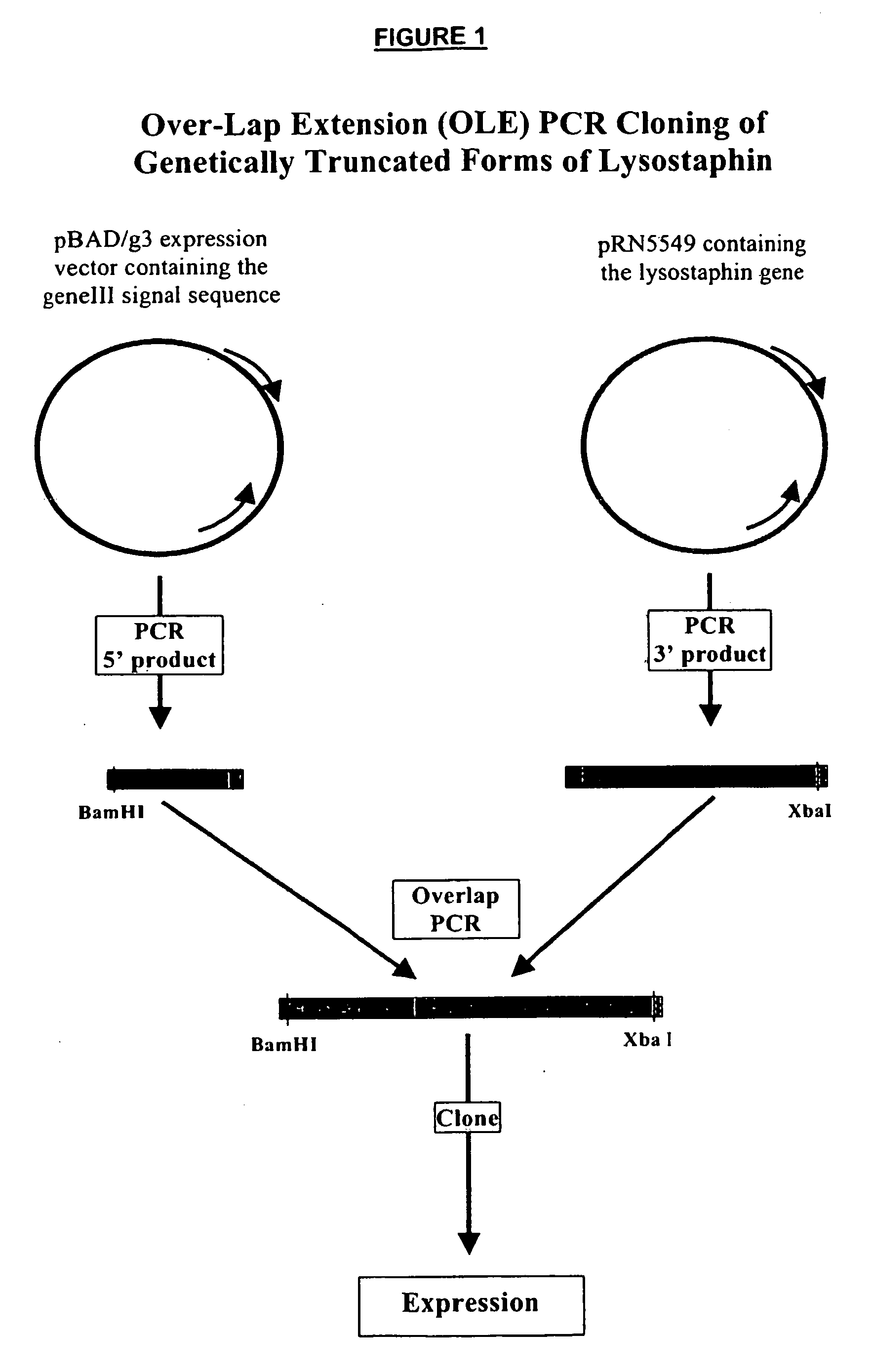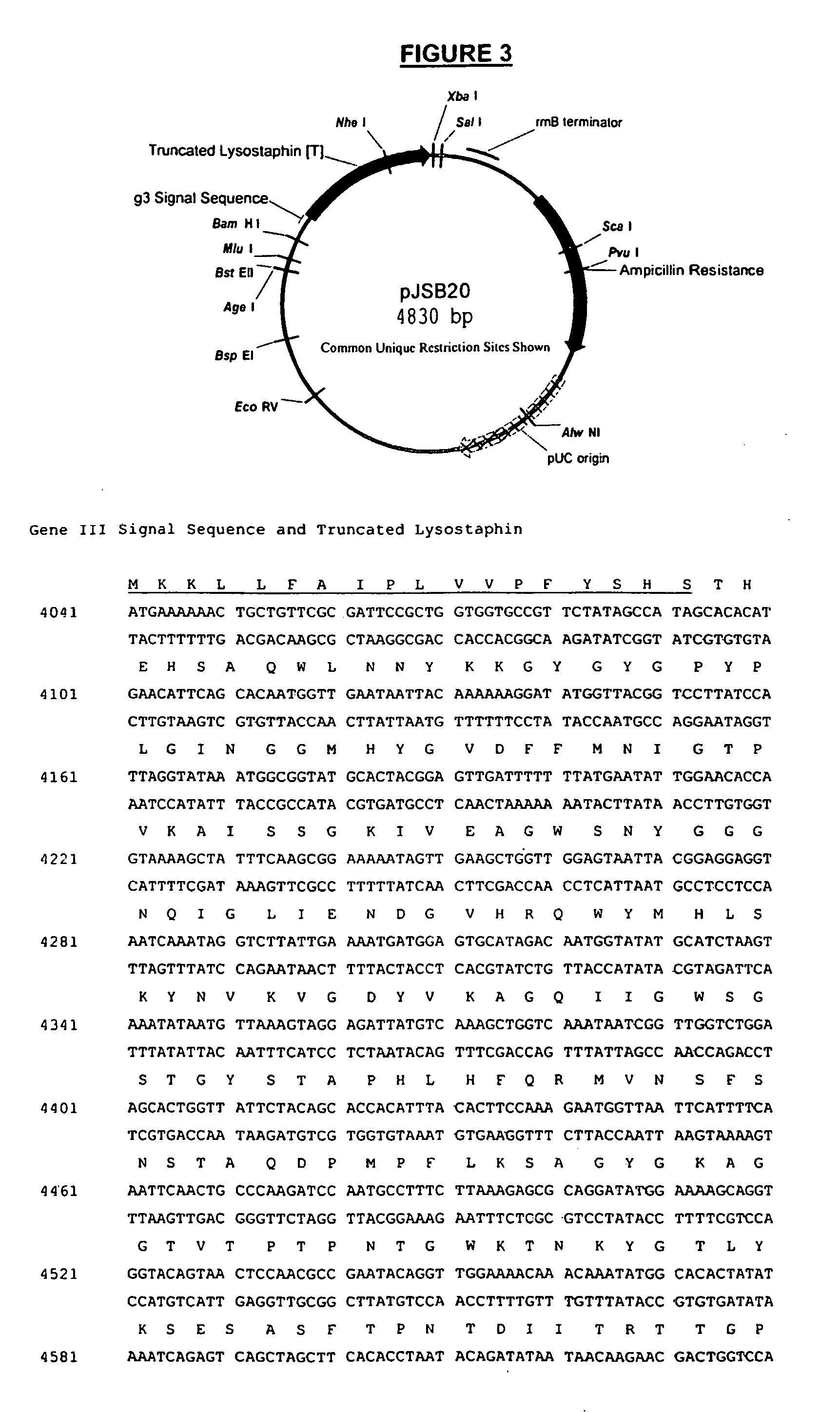Truncated lysostaphin molecule with enhanced staphylolytic activity
a lysostaphin and lysostaphin technology, applied in the field of recombinant truncated lysostaphin, can solve the problems of increasing the concern and need for timely blocking and treatment, significant cause of morbidity and mortality, infections in hospitalized patients, etc., to inhibit the spread of hospital-acquired staphylococcal strains in the community, the effect of reducing individual infections
- Summary
- Abstract
- Description
- Claims
- Application Information
AI Technical Summary
Benefits of technology
Problems solved by technology
Method used
Image
Examples
example 1
Construction of an Expression Plasmid for Intracellular Expression of Homogenous Truncated Lysostaphin
[0053] Polymerase Chain Reaction (PCR) was used to amplify a fragment of the lysostaphin gene and the resulting fragment was cloned into pBAD / glll expression vector (Invitrogen). A form of truncated lysostaphin was generated and fused directly to a translation start methionine for intracellular expression in E. coli. FIG. 1 provides the cloning strategies used for production of the plasmid of this example and Example 2 below.
[0054] To complete the fusion of the lysostaphin expression cassettes, the 5′ and 3′ ends were amplified from different templates and then connected using overlap extension PCR (“OLE-PCR”). Specifically, the 5′ fragment containing the upstream expression components was amplified from the pBAD / gill plasmid and the 3′ end, containing the lysostaphin coding sequence, was amplified from a sample of host cells containing the lysostaphin gene, provided by Ambi, Inc....
example 2
Construction of an Expression Plasmid for Extracellular Expression of Truncated Lysostaphin
[0058] As described above, PCR was used to amplify a fragment of the lysostaphin gene and the resulting fragment was cloned into pBAD / gIII expression vector (Invitrogen). In this example, a form of truncated lysostaphin was generated and fused to a signal sequence for secretion into the periplasmic space of E. coli. OLE-PCR was also used to complete the fusion of the lysostaphin expression cassettes as described above, except that the 5′ fragment contained the upstream expression components and the signal sequence for extracellular expression. These 5′ components were also amplified from the pBAD / gIII plasmid. The PCR amplification reactions for the 5′ fragment were as described above except primers JSBX-29 and JSBX-32 were used. Likewise, the 3′ fragment was amplified as described above except that primers JSBX-34 and JSBX-33 were used. OLE-PCR, the cloning of the truncated lysostaphin inser...
example 3
Small Scale Production of Active Truncated Lysostaphin in E.coli
[0060] Overnight cultures of TOP10 cells transformed with pJSB20 or pJSB28 grown at 37° C. were diluted 1:100 in 200 ml LB media supplemented with 100 μg / mL ampicillin. When the OD600 reached 0.5, arabinose was added to 0.2% to induce expression of the lysostaphin protein. The cultures were then allowed to grow for 48 hours at 30° C. Cells were pelleted by centrifugation at 5000×g for 15 minutes. In the case of the intracellular lysostaphin (pJSB28), the cell pellet was treated with B-Per extraction reagent (Pierce) supplemented with 0.125M NaCl following the manufacturer's instructions and the supernatant was collected and analyzed for the presence of lysostaphin and whether the enzyme was active. In the case of secreted lysostaphin (pJSB20), the media supernatant was collected, concentrated using an Amicon spiral ultrafiltration concentrator (S1Y-10 with a 10 KD cutoff) and analyzed for the presence of lysostaphin an...
PUM
| Property | Measurement | Unit |
|---|---|---|
| Fraction | aaaaa | aaaaa |
| Homogeneity | aaaaa | aaaaa |
Abstract
Description
Claims
Application Information
 Login to View More
Login to View More - R&D
- Intellectual Property
- Life Sciences
- Materials
- Tech Scout
- Unparalleled Data Quality
- Higher Quality Content
- 60% Fewer Hallucinations
Browse by: Latest US Patents, China's latest patents, Technical Efficacy Thesaurus, Application Domain, Technology Topic, Popular Technical Reports.
© 2025 PatSnap. All rights reserved.Legal|Privacy policy|Modern Slavery Act Transparency Statement|Sitemap|About US| Contact US: help@patsnap.com



